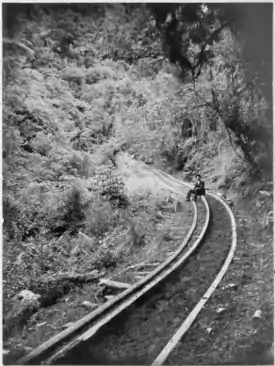Akatarawa Valley
The Akatarawa Valley is a valley in the Tararua Range of New Zealand's North Island. It provides a link from the upper reaches of the Hutt Valley to Waikanae on the Kapiti Coast through rugged hill country. The valley is lowly populated and contains the localities of Reikorangi and Cloustonville. At the Hutt Valley end, the Akatarawa Valley is rugged and the Akatarawa River flows through it. The terrain is less difficult at the Kapiti end, where the Waikanae River flows through part of the valley on its route from its headwaters in the Tararuas to the Tasman Sea, and is met in the valley by tributaries such as the Ngatiawa River and the Reikorangi Stream.
Akatarawa | |
|---|---|
 Price's Bush Tramway, 1903 | |
| Coordinates: 41.011597°S 175.170107°E | |
| Country | New Zealand |
| Island | North Island |
| City | Upper Hutt |
| Population (2006) | |
| • Total | 618 |
Many residents are craftspeople or gardeners, and some gardens are open for public viewing. Also located in the valley is a former Salvation Army youth and family camp that has been upgraded and now operated by the Wellesley Group, and Staglands Wildlife Reserve & Cafe, a conservation project established in 1972. It supports many native and rare birds, insects, and animals in conjunction with the New Zealand Department of Conservation.
An early proposal for the North Island Main Trunk Railway's route out of Wellington featured a line deviating from the Hutt Valley Line portion of the Wairarapa Line and running through the Akatarawa Valley to the west coast; see Haywards–Plimmerton Line. This proposal was considered in the 1870s but abandoned when the Wellington and Manawatu Railway Company chose a route directly out of Wellington via Johnsonville and Porirua.[1] A railway through the Akatarawa Valley has not been seriously considered since this stage, though Price's Bush Tramway and other industrial tramways were built to serve private logging interests. The tramways and mills they served are now closed and little evidence remains of their existence.[2]
References
- Cassells, KR (Ken) (1994). Uncommon Carrier - The History of the Wellington & Manawatu Railway Company, 1882-1908. New Zealand Railway and Locomotive Society. ISBN 0908573634.
- Nic Campbell, Ramblings With Old Nic 11: Wellington Industrial and Tram Lines, 2003.